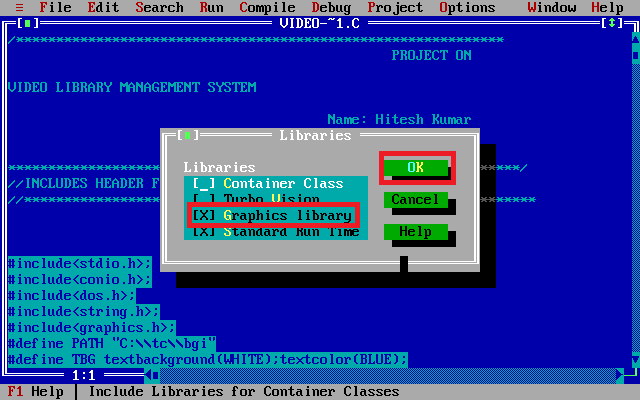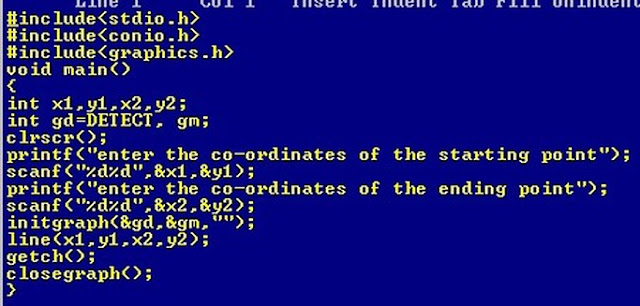Graphics.h File For C
- Graphics.h header file functions with examples in C language This section contains library functions of graphics.h header file with example programs and output. Each function is described with its definition, syntax and description of the program. List of solved programs of 'graphics.h' header file functions.
- Using functions of graphics.h in Turbo C compiler you can make graphics programs, animations, projects, and games. You can draw circles, lines, rectangles, bars and many other geometrical figures. You can change their colors using the available functions and fill them. Following is a list of functions of graphics.h header file.
- Graphics.h Header File C++
- Download Graphics.h File For Dev C++
- Graphics.h Header File For Dev C++
- Graphics.h File For Dev C++ Download
[C Programming]
Gfx.c (the source file: read if you like, but don't change) gfx.h (the header file: read if you like, but don't change) example.c (an example program: go ahead and change this) To compile a program that uses the gfx library, you need to use the following command, which compiles your program with gfx.c then adds the X11 and math libraries. About: TurboC is a linkable library and a set of C header files that make it easier to port C code originally written for Borland’s MS-DOS based Turbo C compiler to GNU gcc. Development code. Development code. Didalamnya berisi 3 buah file yang berekstensi.h dan berekstensi.a, yaitu graphics.h, winbgim.h dan libbgi.a. Copy file graphics.h, winbgim.h ke Folder C: Program Files CodeBlocks MinGW include dan file libbgi.a ke C: Program Files CodeBlocks MinGW lib. Ini untuk CodeBlocks dan Mingw, untuk IDE lain cocok dengan melihat Mingw foldernya. Step 2: Extract the downloaded file. There will be three files: graphics.h; winbgim.h; libbgi.a; Step 3: Copy and paste graphics.h and winbgim.h files into the include folder of compiler directory. (If you have Code::Blocks installed in C drive of your computer, go through: Disk C Program Files CodeBlocks MinGW include. Now copy the graphics.h & winbgim.h header files in C: Program Files CodeBlocks MinGW include directory. Now copy the libbgi.a library file in C: Program Files CodeBlocks MinGW lib directory. Note: It may possible that your codeblocks installation is in another folder like Program Files(x86) by default codeblocks is installed in this directory.
Hello everyone,I am Ritwick, now I will guide you to compile source code of graphics.h and winbgim.h .
| graphic.h in Windows10 |
Installation of CodeBlocks :
1. Install the 'codeblocks-13.12mingw-setup.exe'.(almost 90MB)Copy-Paste Header and Library file :
4. Download the RAR file from here.
RAR file from here.3. Exact all files from the RAR file.
4. Open 'Extra' Folder .
5. Copy the two files Graphic.h and Winbgim.h
4. After successful install, Open Installed file location of CodeBlocks. Make a sure CodeBlocks is closed totally.
Default location :
for 64bit PC: C:Program Files (x86)CodeBlocks
for 32bit PC: C:Program FilesCodeBlocks
7. Open MinGW folder from Installed file location of CodeBlocks.
8. Now paste the two files Graphic.h and Winbgim.h to 'Include' folder.
9. Again go to 'Extra' folder and copy libbgi.a
10. Paste libbgi.a to 'lib'
 folder.
folder.Setup Linker :
Graphics.h Header File C++
11. Now open CodeBlock.12. Open Settings => Compiler
Download Graphics.h File For Dev C++
13. Then click to 'Linker settings'.14. Here you will see 2 box.
15. copy+paste below words to 'Other linker option' (Right side box).
-lbgi -lgdi32 -luser32
Graphics.h Header File For Dev C++
16. And for left side (Link Libraries) : click to 'Add' and then click to '..'
17. Find the libbgi.a file that you have already pasted before.
Default location :
for 64bit PC: C:Program Files (x86)CodeBlocksMinGW lib
for 32bit PC: C:Program Files CodeBlocksMinGW lib
18. Now click to OK,OK.
19. Congratulation, now your CodeBlocks is ready to complile graphics.h
20. Open 'Test Graphics.cpp' to CodeBlocks and try to compile it.
Thank You. :)
- C Programming Tutorial
- C Programming useful Resources
- Selected Reading
Ideazon z engine windows 10. A header file is a file with extension .h which contains C function declarations and macro definitions to be shared between several source files. There are two types of header files: the files that the programmer writes and the files that comes with your compiler.
You request to use a header file in your program by including it with the C preprocessing directive #include, like you have seen inclusion of stdio.h header file, which comes along with your compiler.
Including a header file is equal to copying the content of the header file but we do not do it because it will be error-prone and it is not a good idea to copy the content of a header file in the source files, especially if we have multiple source files in a program.
A simple practice in C or C++ programs is that we keep all the constants, macros, system wide global variables, and function prototypes in the header files and include that header file wherever it is required.
Include Syntax
Both the user and the system header files are included using the preprocessing directive #include. It has the following two forms −
This form is used for system header files. It searches for a file named 'file' in a standard list of system directories. You can prepend directories to this list with the -I option while compiling your source code.
This form is used for header files of your own program. It searches for a file named 'file' in the directory containing the current file. You can prepend directories to this list with the -I option while compiling your source code.
Include Operation
The #include directive works by directing the C preprocessor to scan the specified file as input before continuing with the rest of the current source file. The output from the preprocessor contains the output already generated, followed by the output resulting from the included file, followed by the output that comes from the text after the #include directive. For example, if you have a header file header.h as follows −
and a main program called program.c that uses the header file, like this −
the compiler will see the same token stream as it would if program.c read.
Once-Only Headers
If a header file happens to be included twice, the compiler will process its contents twice and it will result in an error. The standard way to prevent this is to enclose the entire real contents of the file in a conditional, like this −
This construct is commonly known as a wrapper #ifndef. When the header is included again, the conditional will be false, because HEADER_FILE is defined. The preprocessor will skip over the entire contents of the file, and the compiler will not see it twice.
Computed Includes
Sometimes it is necessary to select one of the several different header files to be included into your program. For instance, they might specify configuration parameters to be used on different sorts of operating systems. You could do this with a series of conditionals as follows −
But as it grows, it becomes tedious, instead the preprocessor offers the ability to use a macro for the header name. This is called a computed include. Instead of writing a header name as the direct argument of #include, you simply put a macro name there − Sharp al 2030 driver download.
Graphics.h File For Dev C++ Download
SYSTEM_H will be expanded, and the preprocessor will look for system_1.h as if the #include had been written that way originally. SYSTEM_H could be defined by your Makefile with a -D option.